Exploring Aseptic Non-Touch Technique: Skills and Professional Issues
VerifiedAdded on 2023/05/31
|10
|2896
|428
Essay
AI Summary
This essay provides a critical discussion of Aseptic Non-Touch Technique (ANTT), an essential procedure for protecting patients from infection during invasive procedures. It addresses the professional issues associated with ANTT, such as its time-consuming nature and potential conflicts with established practices. The essay outlines the essential skills required for undertaking ANTT, emphasizing adherence to standard policies and principles. It also explores factors that can impact nursing care when using ANTT, including a lack of belief in the technique, resource constraints, and the influence of hospital hierarchies. The essay highlights the importance of training, standardization, and ongoing audits to ensure the effective implementation of ANTT and reduce healthcare-acquired infections. The author's personal learning and future skill requirements related to ANTT are also discussed.
Contribute Materials
Your contribution can guide someone’s learning journey. Share your
documents today.
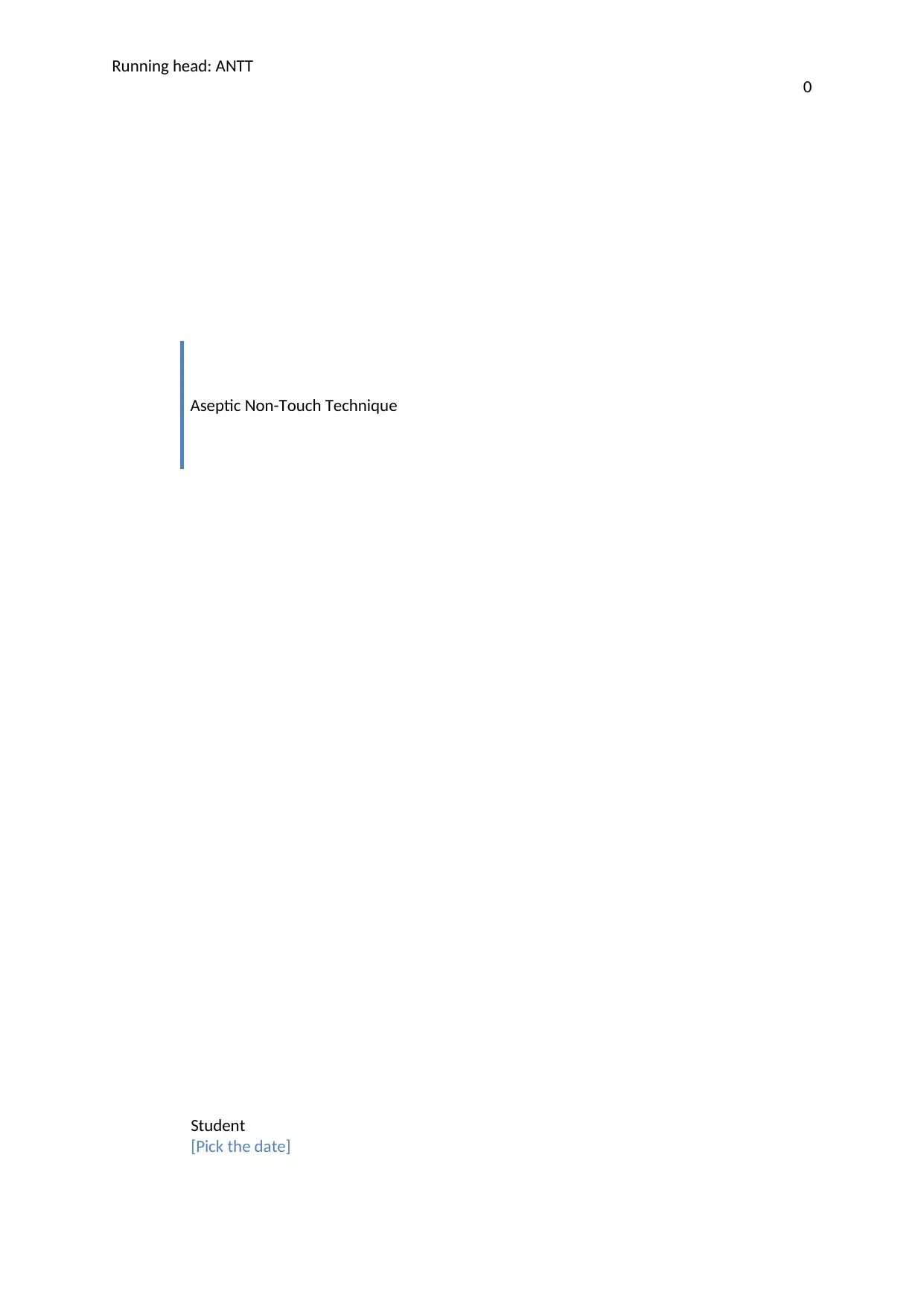
Running head: ANTT
0
Aseptic Non-Touch Technique
Student
[Pick the date]
0
Aseptic Non-Touch Technique
Student
[Pick the date]
Secure Best Marks with AI Grader
Need help grading? Try our AI Grader for instant feedback on your assignments.
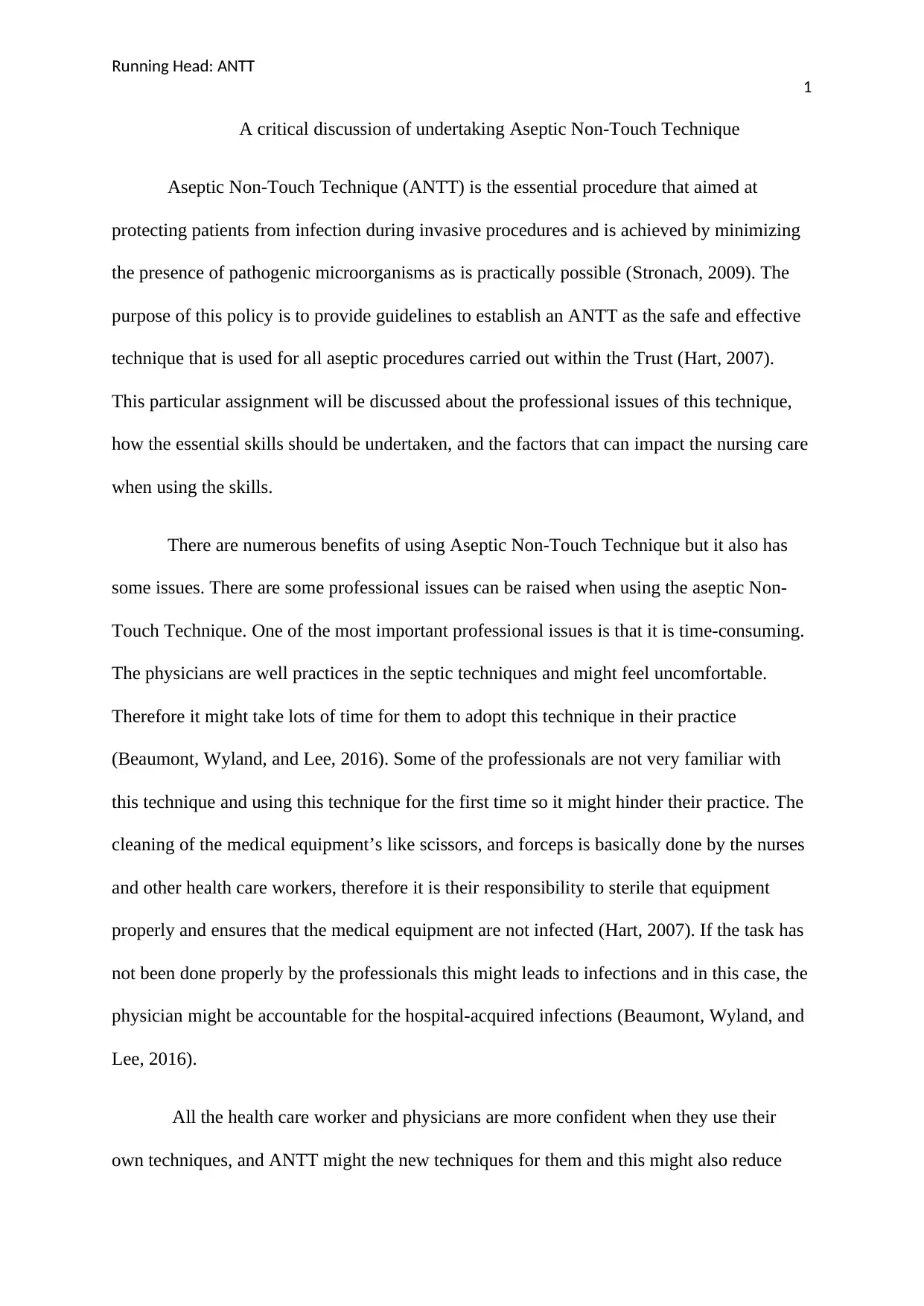
Running Head: ANTT
1
A critical discussion of undertaking Aseptic Non-Touch Technique
Aseptic Non-Touch Technique (ANTT) is the essential procedure that aimed at
protecting patients from infection during invasive procedures and is achieved by minimizing
the presence of pathogenic microorganisms as is practically possible (Stronach, 2009). The
purpose of this policy is to provide guidelines to establish an ANTT as the safe and effective
technique that is used for all aseptic procedures carried out within the Trust (Hart, 2007).
This particular assignment will be discussed about the professional issues of this technique,
how the essential skills should be undertaken, and the factors that can impact the nursing care
when using the skills.
There are numerous benefits of using Aseptic Non-Touch Technique but it also has
some issues. There are some professional issues can be raised when using the aseptic Non-
Touch Technique. One of the most important professional issues is that it is time-consuming.
The physicians are well practices in the septic techniques and might feel uncomfortable.
Therefore it might take lots of time for them to adopt this technique in their practice
(Beaumont, Wyland, and Lee, 2016). Some of the professionals are not very familiar with
this technique and using this technique for the first time so it might hinder their practice. The
cleaning of the medical equipment’s like scissors, and forceps is basically done by the nurses
and other health care workers, therefore it is their responsibility to sterile that equipment
properly and ensures that the medical equipment are not infected (Hart, 2007). If the task has
not been done properly by the professionals this might leads to infections and in this case, the
physician might be accountable for the hospital-acquired infections (Beaumont, Wyland, and
Lee, 2016).
All the health care worker and physicians are more confident when they use their
own techniques, and ANTT might the new techniques for them and this might also reduce
1
A critical discussion of undertaking Aseptic Non-Touch Technique
Aseptic Non-Touch Technique (ANTT) is the essential procedure that aimed at
protecting patients from infection during invasive procedures and is achieved by minimizing
the presence of pathogenic microorganisms as is practically possible (Stronach, 2009). The
purpose of this policy is to provide guidelines to establish an ANTT as the safe and effective
technique that is used for all aseptic procedures carried out within the Trust (Hart, 2007).
This particular assignment will be discussed about the professional issues of this technique,
how the essential skills should be undertaken, and the factors that can impact the nursing care
when using the skills.
There are numerous benefits of using Aseptic Non-Touch Technique but it also has
some issues. There are some professional issues can be raised when using the aseptic Non-
Touch Technique. One of the most important professional issues is that it is time-consuming.
The physicians are well practices in the septic techniques and might feel uncomfortable.
Therefore it might take lots of time for them to adopt this technique in their practice
(Beaumont, Wyland, and Lee, 2016). Some of the professionals are not very familiar with
this technique and using this technique for the first time so it might hinder their practice. The
cleaning of the medical equipment’s like scissors, and forceps is basically done by the nurses
and other health care workers, therefore it is their responsibility to sterile that equipment
properly and ensures that the medical equipment are not infected (Hart, 2007). If the task has
not been done properly by the professionals this might leads to infections and in this case, the
physician might be accountable for the hospital-acquired infections (Beaumont, Wyland, and
Lee, 2016).
All the health care worker and physicians are more confident when they use their
own techniques, and ANTT might the new techniques for them and this might also reduce
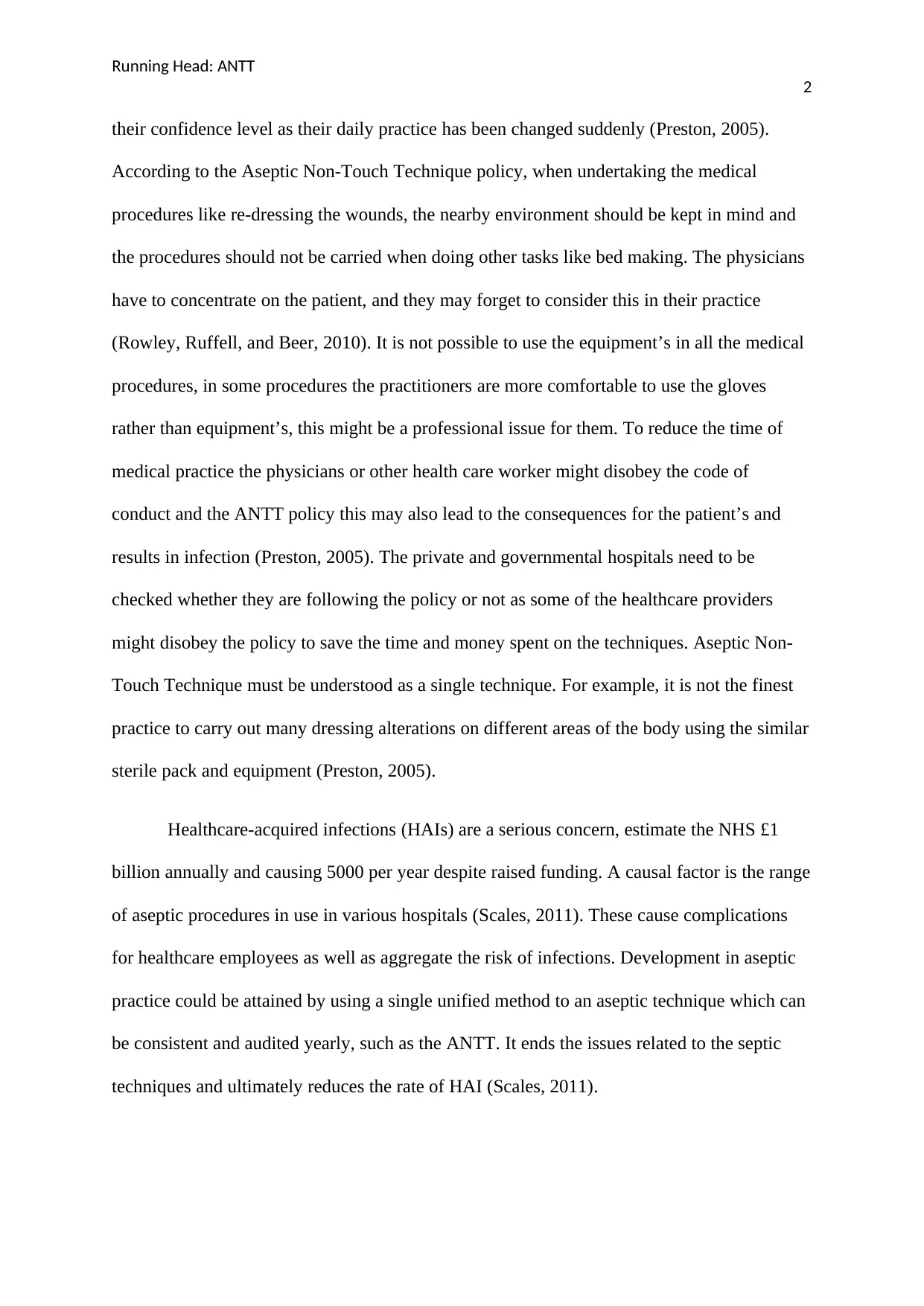
Running Head: ANTT
2
their confidence level as their daily practice has been changed suddenly (Preston, 2005).
According to the Aseptic Non-Touch Technique policy, when undertaking the medical
procedures like re-dressing the wounds, the nearby environment should be kept in mind and
the procedures should not be carried when doing other tasks like bed making. The physicians
have to concentrate on the patient, and they may forget to consider this in their practice
(Rowley, Ruffell, and Beer, 2010). It is not possible to use the equipment’s in all the medical
procedures, in some procedures the practitioners are more comfortable to use the gloves
rather than equipment’s, this might be a professional issue for them. To reduce the time of
medical practice the physicians or other health care worker might disobey the code of
conduct and the ANTT policy this may also lead to the consequences for the patient’s and
results in infection (Preston, 2005). The private and governmental hospitals need to be
checked whether they are following the policy or not as some of the healthcare providers
might disobey the policy to save the time and money spent on the techniques. Aseptic Non-
Touch Technique must be understood as a single technique. For example, it is not the finest
practice to carry out many dressing alterations on different areas of the body using the similar
sterile pack and equipment (Preston, 2005).
Healthcare-acquired infections (HAIs) are a serious concern, estimate the NHS £1
billion annually and causing 5000 per year despite raised funding. A causal factor is the range
of aseptic procedures in use in various hospitals (Scales, 2011). These cause complications
for healthcare employees as well as aggregate the risk of infections. Development in aseptic
practice could be attained by using a single unified method to an aseptic technique which can
be consistent and audited yearly, such as the ANTT. It ends the issues related to the septic
techniques and ultimately reduces the rate of HAI (Scales, 2011).
2
their confidence level as their daily practice has been changed suddenly (Preston, 2005).
According to the Aseptic Non-Touch Technique policy, when undertaking the medical
procedures like re-dressing the wounds, the nearby environment should be kept in mind and
the procedures should not be carried when doing other tasks like bed making. The physicians
have to concentrate on the patient, and they may forget to consider this in their practice
(Rowley, Ruffell, and Beer, 2010). It is not possible to use the equipment’s in all the medical
procedures, in some procedures the practitioners are more comfortable to use the gloves
rather than equipment’s, this might be a professional issue for them. To reduce the time of
medical practice the physicians or other health care worker might disobey the code of
conduct and the ANTT policy this may also lead to the consequences for the patient’s and
results in infection (Preston, 2005). The private and governmental hospitals need to be
checked whether they are following the policy or not as some of the healthcare providers
might disobey the policy to save the time and money spent on the techniques. Aseptic Non-
Touch Technique must be understood as a single technique. For example, it is not the finest
practice to carry out many dressing alterations on different areas of the body using the similar
sterile pack and equipment (Preston, 2005).
Healthcare-acquired infections (HAIs) are a serious concern, estimate the NHS £1
billion annually and causing 5000 per year despite raised funding. A causal factor is the range
of aseptic procedures in use in various hospitals (Scales, 2011). These cause complications
for healthcare employees as well as aggregate the risk of infections. Development in aseptic
practice could be attained by using a single unified method to an aseptic technique which can
be consistent and audited yearly, such as the ANTT. It ends the issues related to the septic
techniques and ultimately reduces the rate of HAI (Scales, 2011).
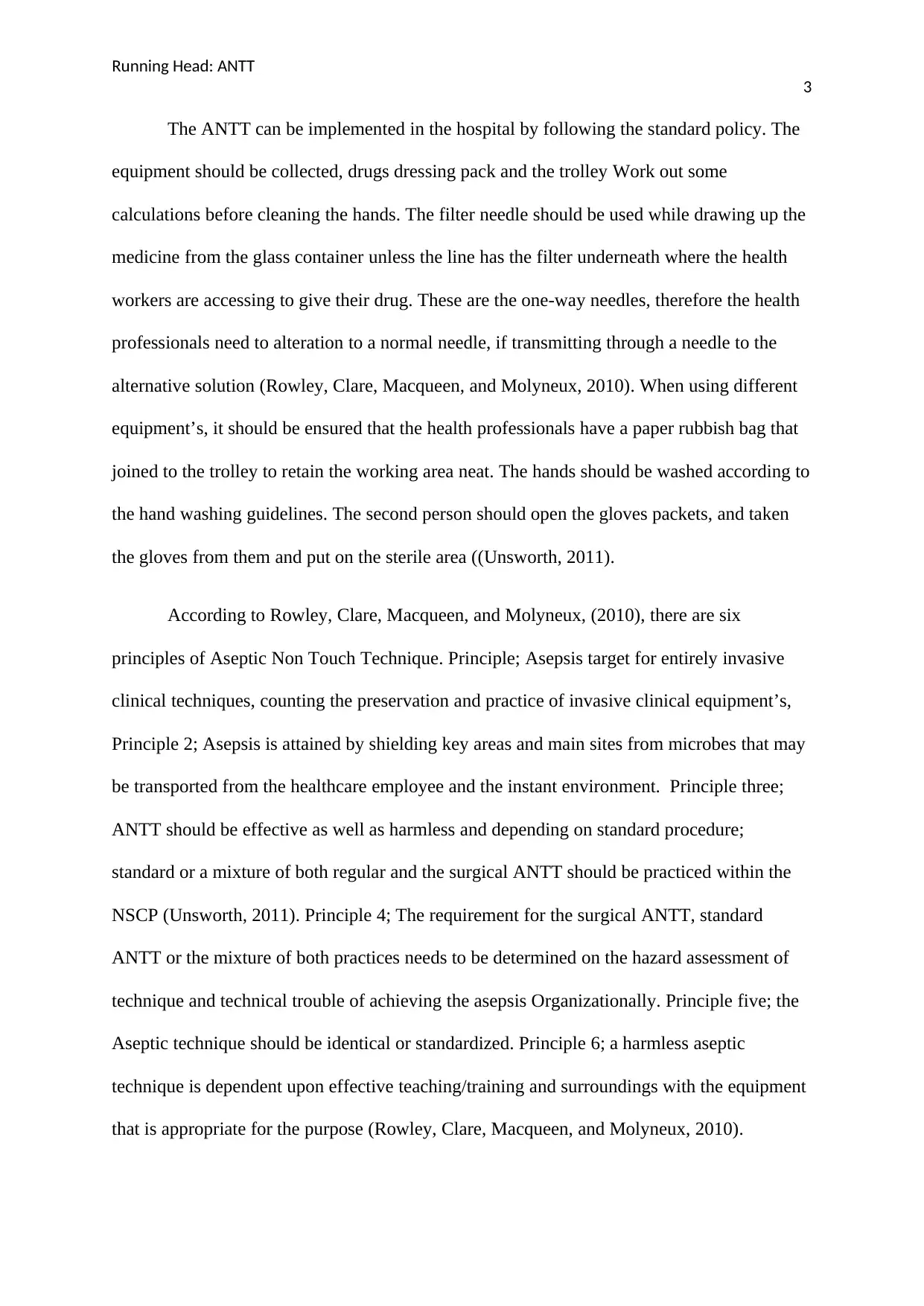
Running Head: ANTT
3
The ANTT can be implemented in the hospital by following the standard policy. The
equipment should be collected, drugs dressing pack and the trolley Work out some
calculations before cleaning the hands. The filter needle should be used while drawing up the
medicine from the glass container unless the line has the filter underneath where the health
workers are accessing to give their drug. These are the one-way needles, therefore the health
professionals need to alteration to a normal needle, if transmitting through a needle to the
alternative solution (Rowley, Clare, Macqueen, and Molyneux, 2010). When using different
equipment’s, it should be ensured that the health professionals have a paper rubbish bag that
joined to the trolley to retain the working area neat. The hands should be washed according to
the hand washing guidelines. The second person should open the gloves packets, and taken
the gloves from them and put on the sterile area ((Unsworth, 2011).
According to Rowley, Clare, Macqueen, and Molyneux, (2010), there are six
principles of Aseptic Non Touch Technique. Principle; Asepsis target for entirely invasive
clinical techniques, counting the preservation and practice of invasive clinical equipment’s,
Principle 2; Asepsis is attained by shielding key areas and main sites from microbes that may
be transported from the healthcare employee and the instant environment. Principle three;
ANTT should be effective as well as harmless and depending on standard procedure;
standard or a mixture of both regular and the surgical ANTT should be practiced within the
NSCP (Unsworth, 2011). Principle 4; The requirement for the surgical ANTT, standard
ANTT or the mixture of both practices needs to be determined on the hazard assessment of
technique and technical trouble of achieving the asepsis Organizationally. Principle five; the
Aseptic technique should be identical or standardized. Principle 6; a harmless aseptic
technique is dependent upon effective teaching/training and surroundings with the equipment
that is appropriate for the purpose (Rowley, Clare, Macqueen, and Molyneux, 2010).
3
The ANTT can be implemented in the hospital by following the standard policy. The
equipment should be collected, drugs dressing pack and the trolley Work out some
calculations before cleaning the hands. The filter needle should be used while drawing up the
medicine from the glass container unless the line has the filter underneath where the health
workers are accessing to give their drug. These are the one-way needles, therefore the health
professionals need to alteration to a normal needle, if transmitting through a needle to the
alternative solution (Rowley, Clare, Macqueen, and Molyneux, 2010). When using different
equipment’s, it should be ensured that the health professionals have a paper rubbish bag that
joined to the trolley to retain the working area neat. The hands should be washed according to
the hand washing guidelines. The second person should open the gloves packets, and taken
the gloves from them and put on the sterile area ((Unsworth, 2011).
According to Rowley, Clare, Macqueen, and Molyneux, (2010), there are six
principles of Aseptic Non Touch Technique. Principle; Asepsis target for entirely invasive
clinical techniques, counting the preservation and practice of invasive clinical equipment’s,
Principle 2; Asepsis is attained by shielding key areas and main sites from microbes that may
be transported from the healthcare employee and the instant environment. Principle three;
ANTT should be effective as well as harmless and depending on standard procedure;
standard or a mixture of both regular and the surgical ANTT should be practiced within the
NSCP (Unsworth, 2011). Principle 4; The requirement for the surgical ANTT, standard
ANTT or the mixture of both practices needs to be determined on the hazard assessment of
technique and technical trouble of achieving the asepsis Organizationally. Principle five; the
Aseptic technique should be identical or standardized. Principle 6; a harmless aseptic
technique is dependent upon effective teaching/training and surroundings with the equipment
that is appropriate for the purpose (Rowley, Clare, Macqueen, and Molyneux, 2010).
Secure Best Marks with AI Grader
Need help grading? Try our AI Grader for instant feedback on your assignments.
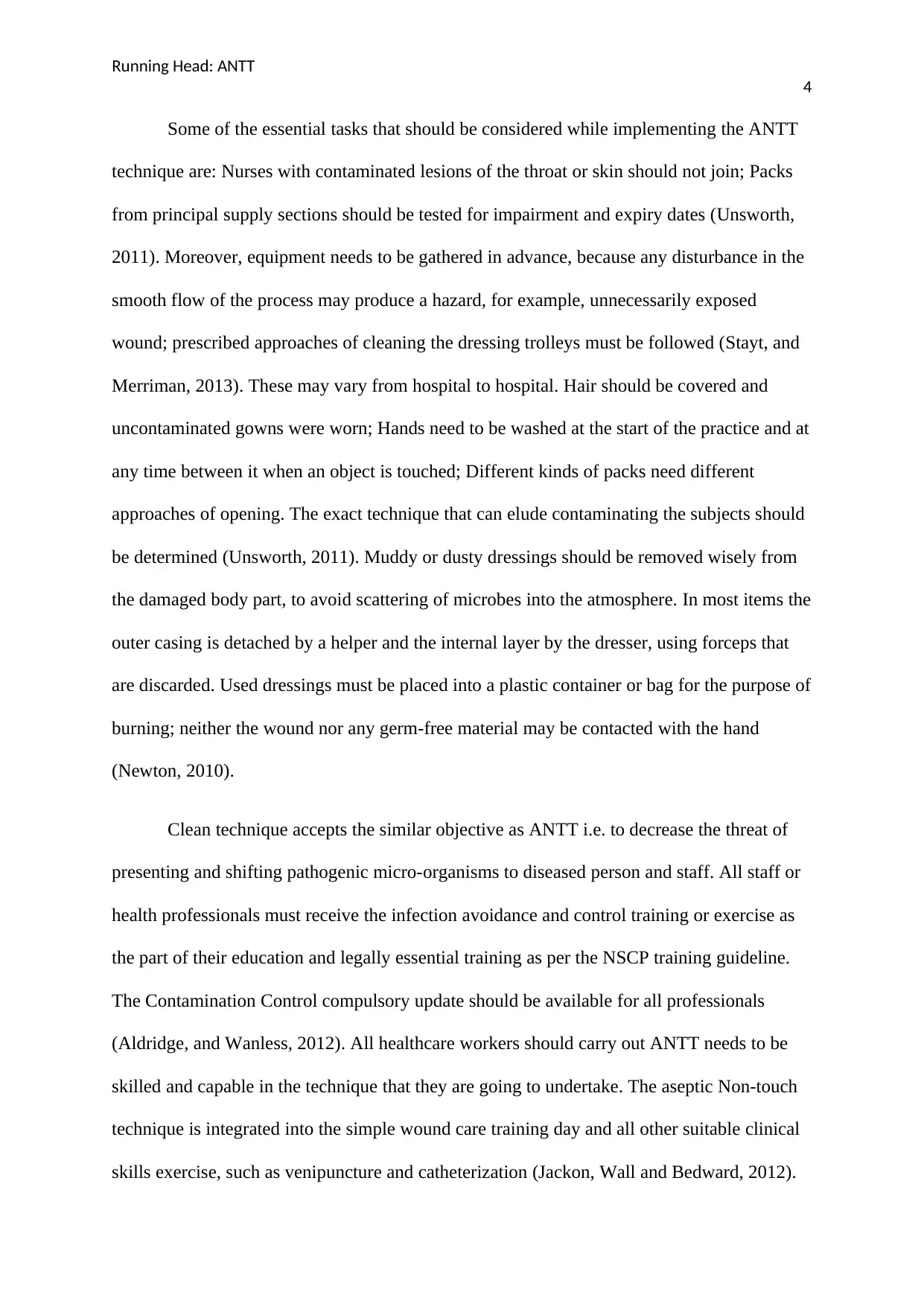
Running Head: ANTT
4
Some of the essential tasks that should be considered while implementing the ANTT
technique are: Nurses with contaminated lesions of the throat or skin should not join; Packs
from principal supply sections should be tested for impairment and expiry dates (Unsworth,
2011). Moreover, equipment needs to be gathered in advance, because any disturbance in the
smooth flow of the process may produce a hazard, for example, unnecessarily exposed
wound; prescribed approaches of cleaning the dressing trolleys must be followed (Stayt, and
Merriman, 2013). These may vary from hospital to hospital. Hair should be covered and
uncontaminated gowns were worn; Hands need to be washed at the start of the practice and at
any time between it when an object is touched; Different kinds of packs need different
approaches of opening. The exact technique that can elude contaminating the subjects should
be determined (Unsworth, 2011). Muddy or dusty dressings should be removed wisely from
the damaged body part, to avoid scattering of microbes into the atmosphere. In most items the
outer casing is detached by a helper and the internal layer by the dresser, using forceps that
are discarded. Used dressings must be placed into a plastic container or bag for the purpose of
burning; neither the wound nor any germ-free material may be contacted with the hand
(Newton, 2010).
Clean technique accepts the similar objective as ANTT i.e. to decrease the threat of
presenting and shifting pathogenic micro-organisms to diseased person and staff. All staff or
health professionals must receive the infection avoidance and control training or exercise as
the part of their education and legally essential training as per the NSCP training guideline.
The Contamination Control compulsory update should be available for all professionals
(Aldridge, and Wanless, 2012). All healthcare workers should carry out ANTT needs to be
skilled and capable in the technique that they are going to undertake. The aseptic Non-touch
technique is integrated into the simple wound care training day and all other suitable clinical
skills exercise, such as venipuncture and catheterization (Jackon, Wall and Bedward, 2012).
4
Some of the essential tasks that should be considered while implementing the ANTT
technique are: Nurses with contaminated lesions of the throat or skin should not join; Packs
from principal supply sections should be tested for impairment and expiry dates (Unsworth,
2011). Moreover, equipment needs to be gathered in advance, because any disturbance in the
smooth flow of the process may produce a hazard, for example, unnecessarily exposed
wound; prescribed approaches of cleaning the dressing trolleys must be followed (Stayt, and
Merriman, 2013). These may vary from hospital to hospital. Hair should be covered and
uncontaminated gowns were worn; Hands need to be washed at the start of the practice and at
any time between it when an object is touched; Different kinds of packs need different
approaches of opening. The exact technique that can elude contaminating the subjects should
be determined (Unsworth, 2011). Muddy or dusty dressings should be removed wisely from
the damaged body part, to avoid scattering of microbes into the atmosphere. In most items the
outer casing is detached by a helper and the internal layer by the dresser, using forceps that
are discarded. Used dressings must be placed into a plastic container or bag for the purpose of
burning; neither the wound nor any germ-free material may be contacted with the hand
(Newton, 2010).
Clean technique accepts the similar objective as ANTT i.e. to decrease the threat of
presenting and shifting pathogenic micro-organisms to diseased person and staff. All staff or
health professionals must receive the infection avoidance and control training or exercise as
the part of their education and legally essential training as per the NSCP training guideline.
The Contamination Control compulsory update should be available for all professionals
(Aldridge, and Wanless, 2012). All healthcare workers should carry out ANTT needs to be
skilled and capable in the technique that they are going to undertake. The aseptic Non-touch
technique is integrated into the simple wound care training day and all other suitable clinical
skills exercise, such as venipuncture and catheterization (Jackon, Wall and Bedward, 2012).
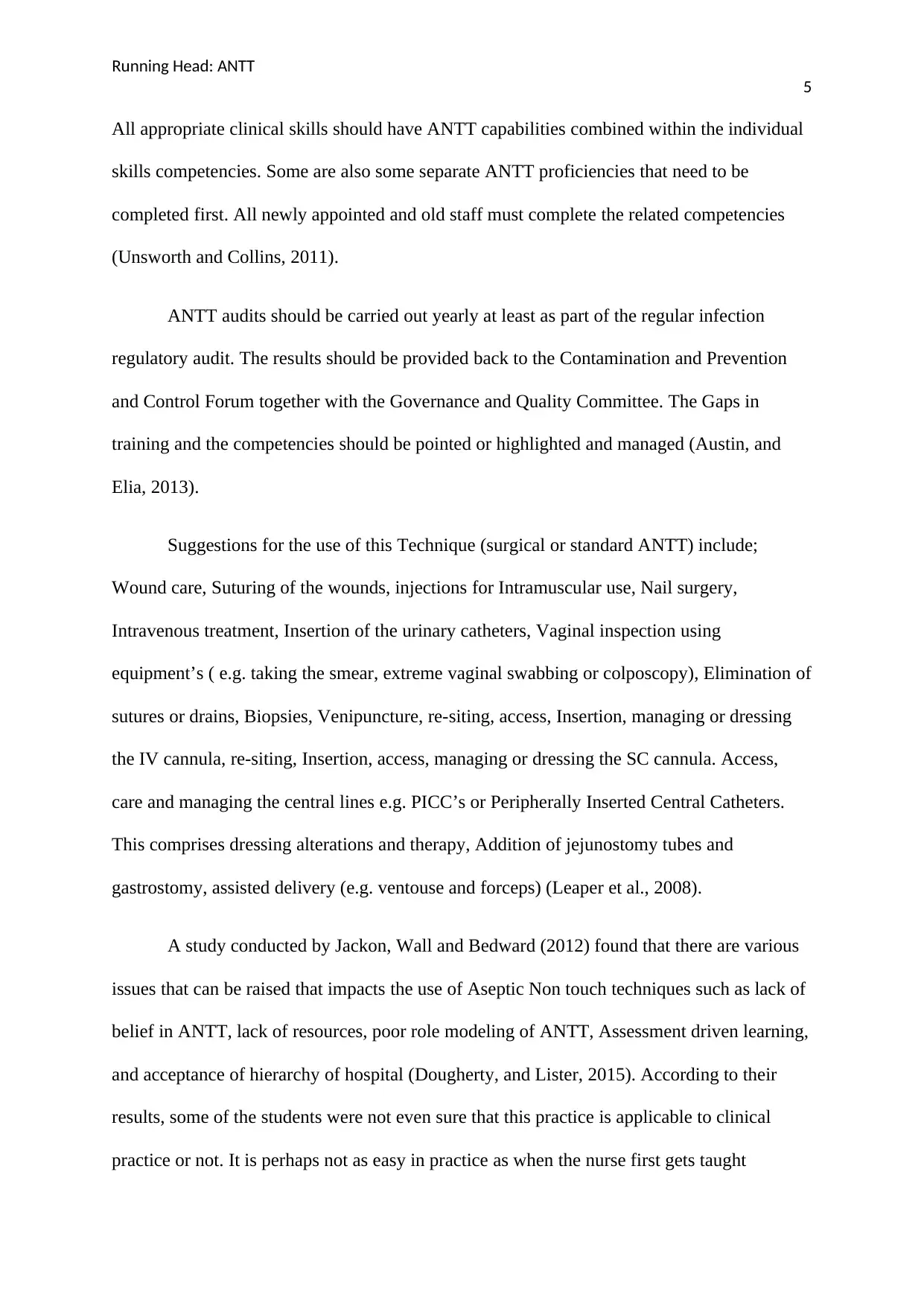
Running Head: ANTT
5
All appropriate clinical skills should have ANTT capabilities combined within the individual
skills competencies. Some are also some separate ANTT proficiencies that need to be
completed first. All newly appointed and old staff must complete the related competencies
(Unsworth and Collins, 2011).
ANTT audits should be carried out yearly at least as part of the regular infection
regulatory audit. The results should be provided back to the Contamination and Prevention
and Control Forum together with the Governance and Quality Committee. The Gaps in
training and the competencies should be pointed or highlighted and managed (Austin, and
Elia, 2013).
Suggestions for the use of this Technique (surgical or standard ANTT) include;
Wound care, Suturing of the wounds, injections for Intramuscular use, Nail surgery,
Intravenous treatment, Insertion of the urinary catheters, Vaginal inspection using
equipment’s ( e.g. taking the smear, extreme vaginal swabbing or colposcopy), Elimination of
sutures or drains, Biopsies, Venipuncture, re-siting, access, Insertion, managing or dressing
the IV cannula, re-siting, Insertion, access, managing or dressing the SC cannula. Access,
care and managing the central lines e.g. PICC’s or Peripherally Inserted Central Catheters.
This comprises dressing alterations and therapy, Addition of jejunostomy tubes and
gastrostomy, assisted delivery (e.g. ventouse and forceps) (Leaper et al., 2008).
A study conducted by Jackon, Wall and Bedward (2012) found that there are various
issues that can be raised that impacts the use of Aseptic Non touch techniques such as lack of
belief in ANTT, lack of resources, poor role modeling of ANTT, Assessment driven learning,
and acceptance of hierarchy of hospital (Dougherty, and Lister, 2015). According to their
results, some of the students were not even sure that this practice is applicable to clinical
practice or not. It is perhaps not as easy in practice as when the nurse first gets taught
5
All appropriate clinical skills should have ANTT capabilities combined within the individual
skills competencies. Some are also some separate ANTT proficiencies that need to be
completed first. All newly appointed and old staff must complete the related competencies
(Unsworth and Collins, 2011).
ANTT audits should be carried out yearly at least as part of the regular infection
regulatory audit. The results should be provided back to the Contamination and Prevention
and Control Forum together with the Governance and Quality Committee. The Gaps in
training and the competencies should be pointed or highlighted and managed (Austin, and
Elia, 2013).
Suggestions for the use of this Technique (surgical or standard ANTT) include;
Wound care, Suturing of the wounds, injections for Intramuscular use, Nail surgery,
Intravenous treatment, Insertion of the urinary catheters, Vaginal inspection using
equipment’s ( e.g. taking the smear, extreme vaginal swabbing or colposcopy), Elimination of
sutures or drains, Biopsies, Venipuncture, re-siting, access, Insertion, managing or dressing
the IV cannula, re-siting, Insertion, access, managing or dressing the SC cannula. Access,
care and managing the central lines e.g. PICC’s or Peripherally Inserted Central Catheters.
This comprises dressing alterations and therapy, Addition of jejunostomy tubes and
gastrostomy, assisted delivery (e.g. ventouse and forceps) (Leaper et al., 2008).
A study conducted by Jackon, Wall and Bedward (2012) found that there are various
issues that can be raised that impacts the use of Aseptic Non touch techniques such as lack of
belief in ANTT, lack of resources, poor role modeling of ANTT, Assessment driven learning,
and acceptance of hierarchy of hospital (Dougherty, and Lister, 2015). According to their
results, some of the students were not even sure that this practice is applicable to clinical
practice or not. It is perhaps not as easy in practice as when the nurse first gets taught
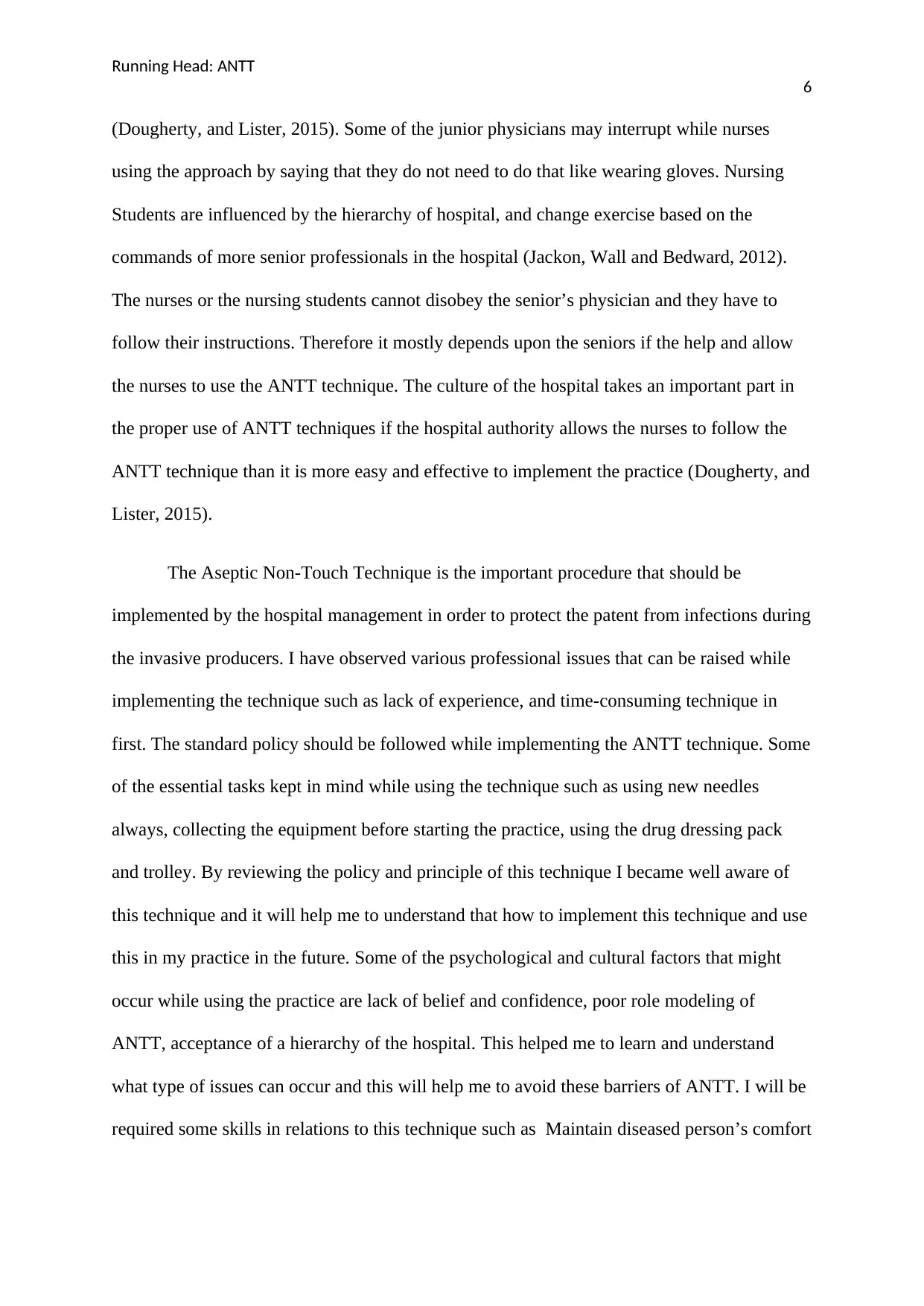
Running Head: ANTT
6
(Dougherty, and Lister, 2015). Some of the junior physicians may interrupt while nurses
using the approach by saying that they do not need to do that like wearing gloves. Nursing
Students are influenced by the hierarchy of hospital, and change exercise based on the
commands of more senior professionals in the hospital (Jackon, Wall and Bedward, 2012).
The nurses or the nursing students cannot disobey the senior’s physician and they have to
follow their instructions. Therefore it mostly depends upon the seniors if the help and allow
the nurses to use the ANTT technique. The culture of the hospital takes an important part in
the proper use of ANTT techniques if the hospital authority allows the nurses to follow the
ANTT technique than it is more easy and effective to implement the practice (Dougherty, and
Lister, 2015).
The Aseptic Non-Touch Technique is the important procedure that should be
implemented by the hospital management in order to protect the patent from infections during
the invasive producers. I have observed various professional issues that can be raised while
implementing the technique such as lack of experience, and time-consuming technique in
first. The standard policy should be followed while implementing the ANTT technique. Some
of the essential tasks kept in mind while using the technique such as using new needles
always, collecting the equipment before starting the practice, using the drug dressing pack
and trolley. By reviewing the policy and principle of this technique I became well aware of
this technique and it will help me to understand that how to implement this technique and use
this in my practice in the future. Some of the psychological and cultural factors that might
occur while using the practice are lack of belief and confidence, poor role modeling of
ANTT, acceptance of a hierarchy of the hospital. This helped me to learn and understand
what type of issues can occur and this will help me to avoid these barriers of ANTT. I will be
required some skills in relations to this technique such as Maintain diseased person’s comfort
6
(Dougherty, and Lister, 2015). Some of the junior physicians may interrupt while nurses
using the approach by saying that they do not need to do that like wearing gloves. Nursing
Students are influenced by the hierarchy of hospital, and change exercise based on the
commands of more senior professionals in the hospital (Jackon, Wall and Bedward, 2012).
The nurses or the nursing students cannot disobey the senior’s physician and they have to
follow their instructions. Therefore it mostly depends upon the seniors if the help and allow
the nurses to use the ANTT technique. The culture of the hospital takes an important part in
the proper use of ANTT techniques if the hospital authority allows the nurses to follow the
ANTT technique than it is more easy and effective to implement the practice (Dougherty, and
Lister, 2015).
The Aseptic Non-Touch Technique is the important procedure that should be
implemented by the hospital management in order to protect the patent from infections during
the invasive producers. I have observed various professional issues that can be raised while
implementing the technique such as lack of experience, and time-consuming technique in
first. The standard policy should be followed while implementing the ANTT technique. Some
of the essential tasks kept in mind while using the technique such as using new needles
always, collecting the equipment before starting the practice, using the drug dressing pack
and trolley. By reviewing the policy and principle of this technique I became well aware of
this technique and it will help me to understand that how to implement this technique and use
this in my practice in the future. Some of the psychological and cultural factors that might
occur while using the practice are lack of belief and confidence, poor role modeling of
ANTT, acceptance of a hierarchy of the hospital. This helped me to learn and understand
what type of issues can occur and this will help me to avoid these barriers of ANTT. I will be
required some skills in relations to this technique such as Maintain diseased person’s comfort
Paraphrase This Document
Need a fresh take? Get an instant paraphrase of this document with our AI Paraphraser
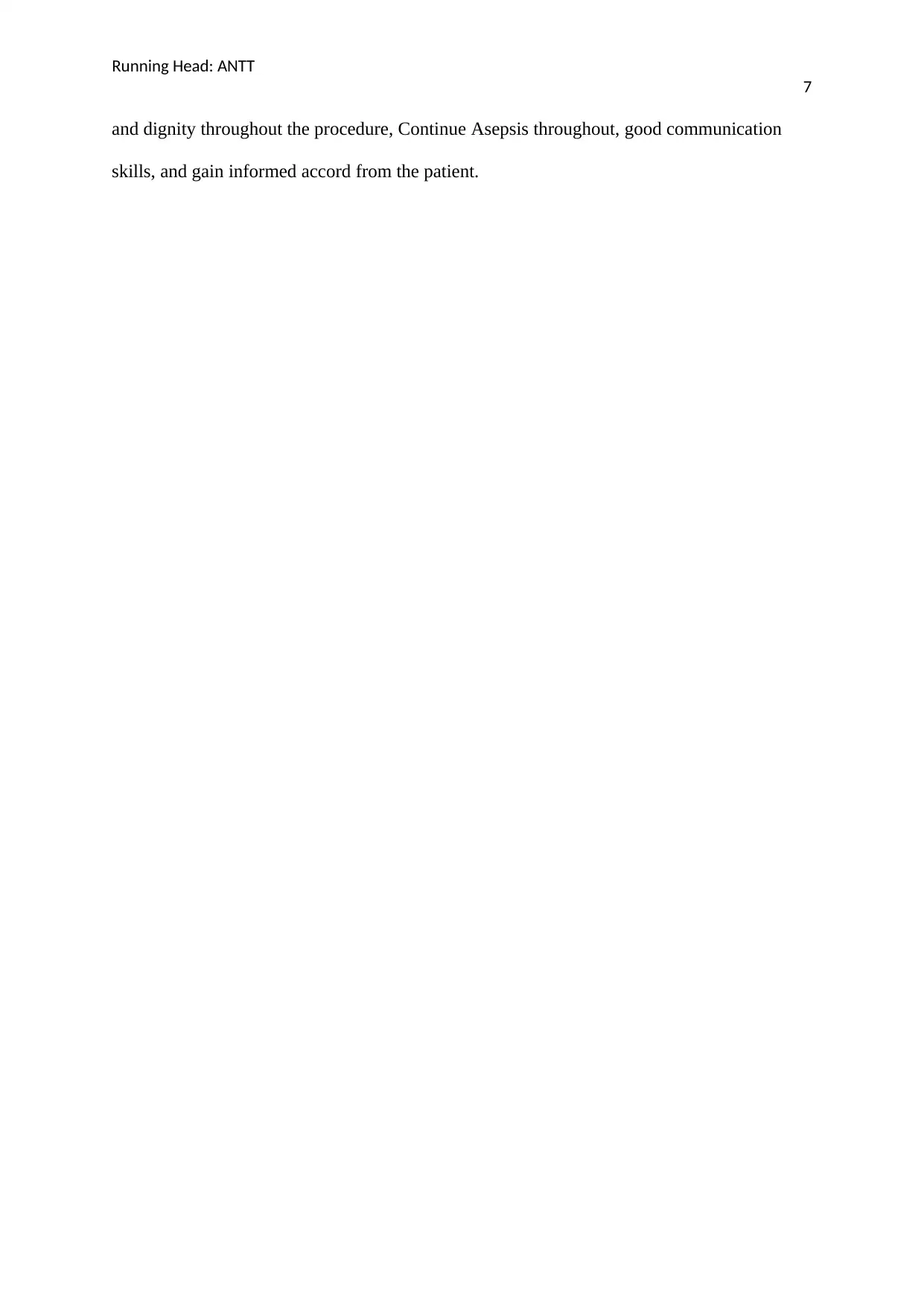
Running Head: ANTT
7
and dignity throughout the procedure, Continue Asepsis throughout, good communication
skills, and gain informed accord from the patient.
7
and dignity throughout the procedure, Continue Asepsis throughout, good communication
skills, and gain informed accord from the patient.
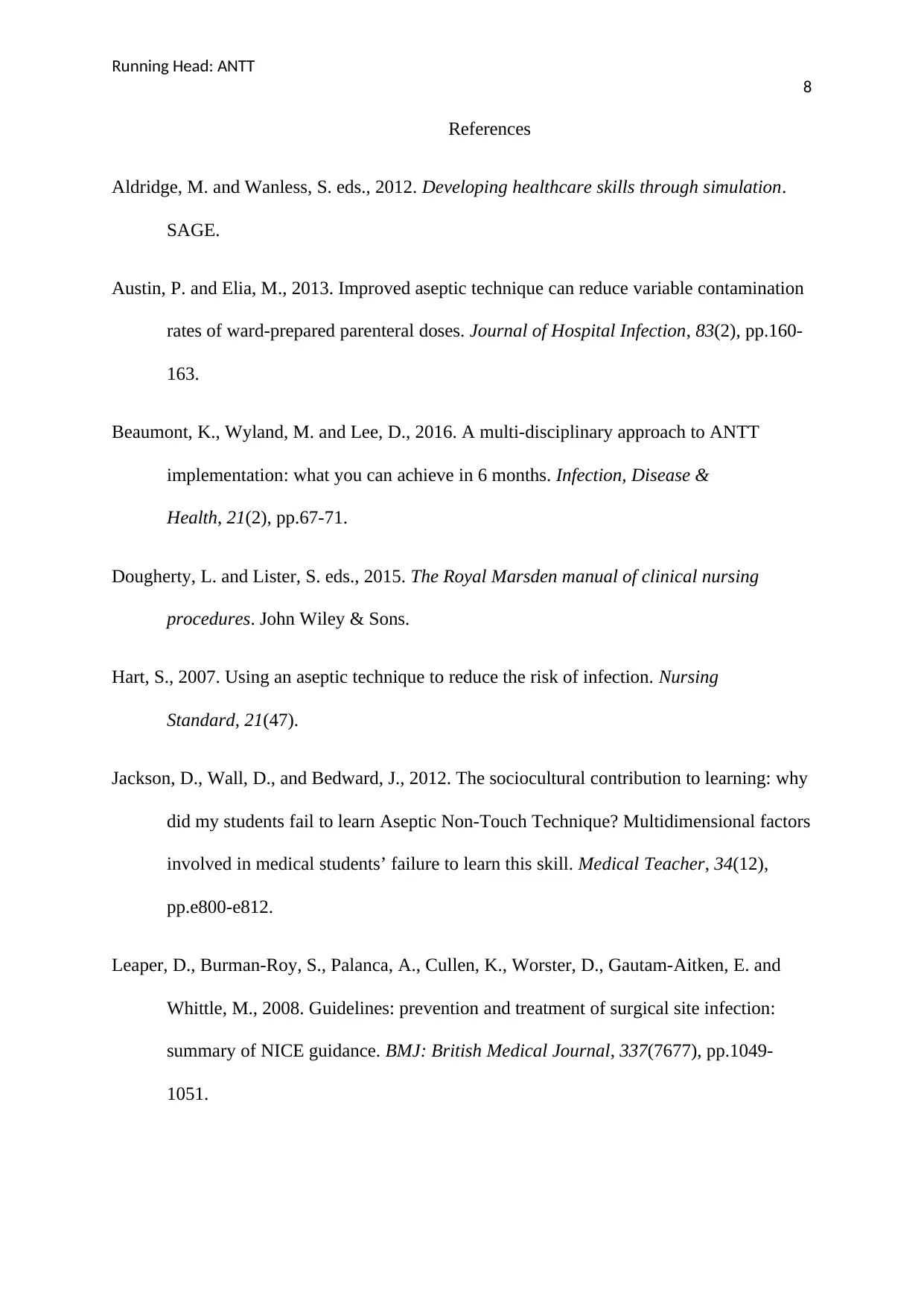
Running Head: ANTT
8
References
Aldridge, M. and Wanless, S. eds., 2012. Developing healthcare skills through simulation.
SAGE.
Austin, P. and Elia, M., 2013. Improved aseptic technique can reduce variable contamination
rates of ward-prepared parenteral doses. Journal of Hospital Infection, 83(2), pp.160-
163.
Beaumont, K., Wyland, M. and Lee, D., 2016. A multi-disciplinary approach to ANTT
implementation: what you can achieve in 6 months. Infection, Disease &
Health, 21(2), pp.67-71.
Dougherty, L. and Lister, S. eds., 2015. The Royal Marsden manual of clinical nursing
procedures. John Wiley & Sons.
Hart, S., 2007. Using an aseptic technique to reduce the risk of infection. Nursing
Standard, 21(47).
Jackson, D., Wall, D., and Bedward, J., 2012. The sociocultural contribution to learning: why
did my students fail to learn Aseptic Non-Touch Technique? Multidimensional factors
involved in medical students’ failure to learn this skill. Medical Teacher, 34(12),
pp.e800-e812.
Leaper, D., Burman-Roy, S., Palanca, A., Cullen, K., Worster, D., Gautam-Aitken, E. and
Whittle, M., 2008. Guidelines: prevention and treatment of surgical site infection:
summary of NICE guidance. BMJ: British Medical Journal, 337(7677), pp.1049-
1051.
8
References
Aldridge, M. and Wanless, S. eds., 2012. Developing healthcare skills through simulation.
SAGE.
Austin, P. and Elia, M., 2013. Improved aseptic technique can reduce variable contamination
rates of ward-prepared parenteral doses. Journal of Hospital Infection, 83(2), pp.160-
163.
Beaumont, K., Wyland, M. and Lee, D., 2016. A multi-disciplinary approach to ANTT
implementation: what you can achieve in 6 months. Infection, Disease &
Health, 21(2), pp.67-71.
Dougherty, L. and Lister, S. eds., 2015. The Royal Marsden manual of clinical nursing
procedures. John Wiley & Sons.
Hart, S., 2007. Using an aseptic technique to reduce the risk of infection. Nursing
Standard, 21(47).
Jackson, D., Wall, D., and Bedward, J., 2012. The sociocultural contribution to learning: why
did my students fail to learn Aseptic Non-Touch Technique? Multidimensional factors
involved in medical students’ failure to learn this skill. Medical Teacher, 34(12),
pp.e800-e812.
Leaper, D., Burman-Roy, S., Palanca, A., Cullen, K., Worster, D., Gautam-Aitken, E. and
Whittle, M., 2008. Guidelines: prevention and treatment of surgical site infection:
summary of NICE guidance. BMJ: British Medical Journal, 337(7677), pp.1049-
1051.
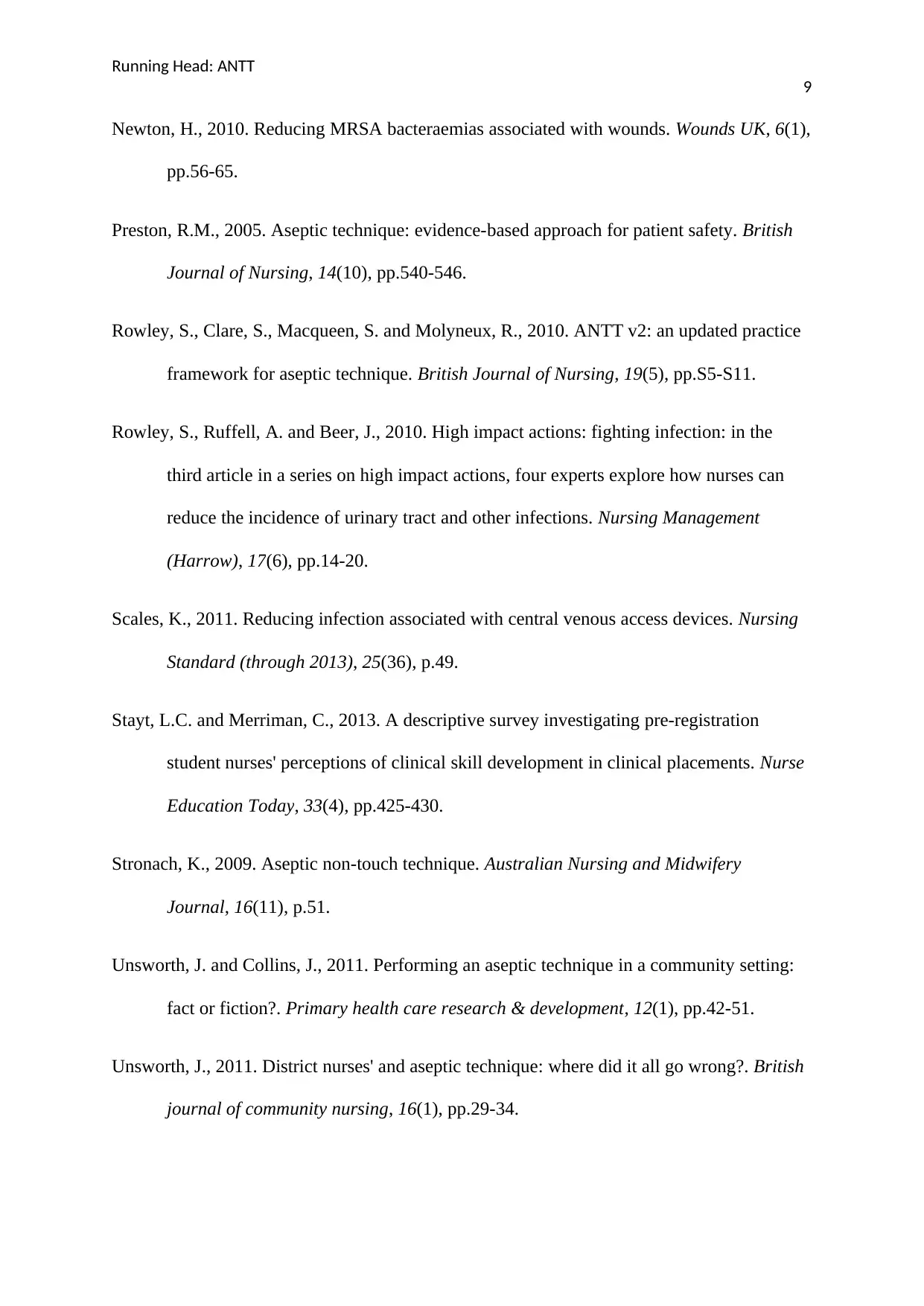
Running Head: ANTT
9
Newton, H., 2010. Reducing MRSA bacteraemias associated with wounds. Wounds UK, 6(1),
pp.56-65.
Preston, R.M., 2005. Aseptic technique: evidence-based approach for patient safety. British
Journal of Nursing, 14(10), pp.540-546.
Rowley, S., Clare, S., Macqueen, S. and Molyneux, R., 2010. ANTT v2: an updated practice
framework for aseptic technique. British Journal of Nursing, 19(5), pp.S5-S11.
Rowley, S., Ruffell, A. and Beer, J., 2010. High impact actions: fighting infection: in the
third article in a series on high impact actions, four experts explore how nurses can
reduce the incidence of urinary tract and other infections. Nursing Management
(Harrow), 17(6), pp.14-20.
Scales, K., 2011. Reducing infection associated with central venous access devices. Nursing
Standard (through 2013), 25(36), p.49.
Stayt, L.C. and Merriman, C., 2013. A descriptive survey investigating pre-registration
student nurses' perceptions of clinical skill development in clinical placements. Nurse
Education Today, 33(4), pp.425-430.
Stronach, K., 2009. Aseptic non-touch technique. Australian Nursing and Midwifery
Journal, 16(11), p.51.
Unsworth, J. and Collins, J., 2011. Performing an aseptic technique in a community setting:
fact or fiction?. Primary health care research & development, 12(1), pp.42-51.
Unsworth, J., 2011. District nurses' and aseptic technique: where did it all go wrong?. British
journal of community nursing, 16(1), pp.29-34.
9
Newton, H., 2010. Reducing MRSA bacteraemias associated with wounds. Wounds UK, 6(1),
pp.56-65.
Preston, R.M., 2005. Aseptic technique: evidence-based approach for patient safety. British
Journal of Nursing, 14(10), pp.540-546.
Rowley, S., Clare, S., Macqueen, S. and Molyneux, R., 2010. ANTT v2: an updated practice
framework for aseptic technique. British Journal of Nursing, 19(5), pp.S5-S11.
Rowley, S., Ruffell, A. and Beer, J., 2010. High impact actions: fighting infection: in the
third article in a series on high impact actions, four experts explore how nurses can
reduce the incidence of urinary tract and other infections. Nursing Management
(Harrow), 17(6), pp.14-20.
Scales, K., 2011. Reducing infection associated with central venous access devices. Nursing
Standard (through 2013), 25(36), p.49.
Stayt, L.C. and Merriman, C., 2013. A descriptive survey investigating pre-registration
student nurses' perceptions of clinical skill development in clinical placements. Nurse
Education Today, 33(4), pp.425-430.
Stronach, K., 2009. Aseptic non-touch technique. Australian Nursing and Midwifery
Journal, 16(11), p.51.
Unsworth, J. and Collins, J., 2011. Performing an aseptic technique in a community setting:
fact or fiction?. Primary health care research & development, 12(1), pp.42-51.
Unsworth, J., 2011. District nurses' and aseptic technique: where did it all go wrong?. British
journal of community nursing, 16(1), pp.29-34.
1 out of 10
Related Documents
Your All-in-One AI-Powered Toolkit for Academic Success.
+13062052269
info@desklib.com
Available 24*7 on WhatsApp / Email
![[object Object]](/_next/static/media/star-bottom.7253800d.svg)
Unlock your academic potential
© 2024 | Zucol Services PVT LTD | All rights reserved.





